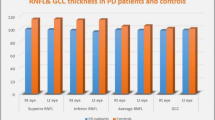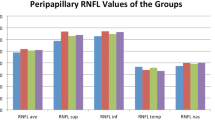Abstract
Parkinson disease is a multisystem neurodegenerative disease which involves not only basal ganglia and extrapyramidal system but also many other neurologic systems such as retinal ganglion cells. Optical coherence tomography (OCT) is a non-invasive method for assessment of retinal nerve fiber layer (RNFL) thickness and its changes in different diseases. To evaluate the RNFL thickness in patients with Parkinson disease (PD), we performed OCT in patients with PD and compared it with a control group. From October 2010 to July 2011, 27 PD patients (54 eyes) and 25 healthy persons (50 eyes) were entered to this analytical cross-sectional study according to the defined criteria. PD patients were categorized into two groups “akinetic rigid (AR) and tremor dominant (TD)”. RNFL was divided into four quadrants and was assessed by OCT. Afterwards; the data were analyzed by bivariate and multivariate models. The RNFL thickness in PD was significantly lower than the control group. Also, the thicknesses of inferior and nasal quadrants of RNFL in TD group were significantly more than AR group. According to these findings, OCT can be used as a sensitive and objective marker for assessment of early neurodegenerative changes of PD and early initiation of neuroprotective treatments. Future studies with adequate sample sizes are recommended to investigate interactions between age, distribution of the disease and type of PD as well as the effects of individual factors.
Similar content being viewed by others
References
Djamgoz MB, Hankins MW, Hirano J, Archer SN (1997) Neurobiology of retinal dopamine in relation to degenerative states of the tissue. Vision Res 37:3509–3529
Korell M, Tanner C (2005) Epidemiology of Parkinson’s disease. In: Ebadi M, Pfeiffer R (eds) Parkinson’s disease. CRC Press, New York, pp 39–50
Braak H, Del Tredici K, Bratzke H et al (2002) Staging of the intracerebral inclusion body pathology associated with idiopathic Parkinson’s disease (preclinical and clinical stages). J Neurol 249:1–5
Bodis-Wollner I (2002) Visualizing the next steps in Parkinson disease. Arch Neurol 59:1233–1234
Diederich NJ, Raman R, Leurgans S, Goetz CG (2002) Progressive worsening of spatial and chromatic processing deficits in Parkinson’s disease. Arch Neurol 59:1249–1252
Hajee ME et al (2009) Inner retinal layer thinning in Parkinson disease. Arch Ophthalmol 127(6):737–741
Altintas O (2008) Correlation between retinal morphological and functional findings and clinical severity in Parkinson’s disease. Doc Ophthalmol 116:137–146
Bodis-Wollner Ivan (2009) Retinopathy in Parkinson disease. J Neural Transm 116:1493–1501
Inzelberg R, Ramirez JA, Niisipeanu P, Ophir A (2004) Retinal nerve fiber layer thinning in Parkinson disease. Vis Res 44:2793–2797
Parisi V, Manni G, Sparado M, Colacino G, Restuccia R, Marchi S, Bucci MG, Pierelli F (1999) Correlation between morphological and functional retinal impairment in multiple sclerosis patients. Invest Ophthal Vis Sci 40:2520–2527
Kanamori A, Nakamura M, Escano MF, Seya R, Maeda H, Negi A (2003) Evaluation of glaucomatous damage of retinal nerve fiber layer thickness measured by optical coherence tomography. Am J Ophthalmol 135:513–520
Hughes AJ et al (1992) Accuracy of clinical diagnosis of idiopathic Parkinson’s disease: a clinico-pathological study of 100 cases. J Neurol Neurosurg Psychiatry 55:181–184
Lewis SJ, Foltynie T, Blackwell AD et al (2005) Heterogeneity of Parkinson’s disease in the early clinical stages using a data driven approach. J Neurol Neurosurg Psychiatry 76:343–348
Harnois C, Di Paolo T (1990) Decreased dopamine in the retinas of patients with Parkinson_s disease. Invest Ophthal Vis Sci 31:2473–2475
Onofrj M, Bodis-Wollner I (1982) Dopaminergic deficiency causes delayed VEPs in rats. Ann Neurol 11:484–490
Masson G, Mestre D, Blin O (1993) Dopaminergic modulation of visual sensitivity in man. Fundam Clin Pharmacol 7(8):449–463
Nowacka B, Lubiński W, Karczewicz D (2010) Ophthalmological and electrophysiological features of Parkinson’s disease. Klin Oczna 112(7–9):247–252
Author information
Authors and Affiliations
Corresponding author
Rights and permissions
About this article
Cite this article
Rohani, M., Langroodi, A.S., Ghourchian, S. et al. Retinal nerve changes in patients with tremor dominant and akinetic rigid Parkinson’s disease. Neurol Sci 34, 689–693 (2013). https://doi.org/10.1007/s10072-012-1125-7
Received:
Accepted:
Published:
Issue Date:
DOI: https://doi.org/10.1007/s10072-012-1125-7




